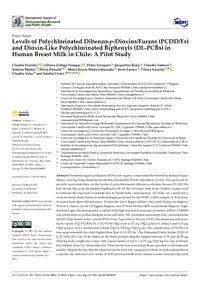Levels of polychlorinated dibenzo-p-dioxins/furans (PCDD/Fs) and dioxin-like polychlorinated biphenyls (DL-PCBs) in human breast milk in Chile: A pilot study
Autor
Foerster, Claudia
Zúñiga-Venegas, Liliana A.
Enríquez, Pedro
Rojas, Jacqueline
Zamora, Claudia
Muñoz, Ximena
Pancetti, Floria
Muñoz-Quezada, María Teresa
Lucero-Mondaca, Boris
Saracini, Chiara
Salas, Claudio
Cortés, Sandra
Fecha
2021Resumen
Persistent organic pollutants (POPs) are organic compounds that resist biochemical degradation, moving long distances across the atmosphere before deposition occurs. Our goal was to provide up-to-date data on the levels of polychlorinated dibenzo-p-dioxins/furans (PCDD/Fs) and dioxin-like polychlorinated biphenyls (DL-PCBs) in breast milk from Chilean women and to estimate the exposure of infants due to breast milk consumption. In Chile, we conducted a cross-sectional study based on methodologies proposed by the WHO, with a sample of 30 women recruited from three defined areas: 10 from the Arica Region (urban; Arica and Parinacota Region), 10 from Coltauco (rural; O’Higgins Region), and 10 from Molina (40% rural; Maule Region). High-resolution gas chromatography coupled with high-resolution mass spectrometry (HRGC/HRMS) was performed on pooled samples from each area. We calculated equivalent toxic concentrations (WHO-TEQ) based on the current WHO Toxic Equivalency Factors (TEF). The minimum and maximum values of ∑ PCDDs/Fs + DL-PCBs-TEQ were 4.317 pg TEQ/g fat in Coltauco and 6.31 pg TEQ/g fat in Arica. Molina had a total TEQ of 5.50 pg TEQ/g fat. The contribution of PCDD/Fs was approximately five-fold higher than that of DL-PCBs. The Estimated Daily Intake (EDI) of ∑ PCDDs/Fs + DL-PCBs based on the three pooled samples ranged between 6.71 and 26.28 pg TEQ/kg body weight (bw)/day, with a mean intake of 16.11 (±6.71) pg TEQ/kg bw/day in breastfed children from 0 to 24 months old. These levels were lower than those reported in international studies. Despite the fact that the observed levels were low compared to those in most industrialized countries, the detection of a variety of POPs in breast milk from Chilean women indicates the need for follow-up studies to determine whether such exposures during childhood could represent a health risk in adulthood.
Fuente
International Journal of Environmental Research and Public Health, 18(9), 4825Link de Acceso
Click aquí para ver el documentoIdentificador DOI
doi.org/10.3390/ijerph18094825Colecciones
La publicación tiene asociados los siguientes ficheros de licencia:


